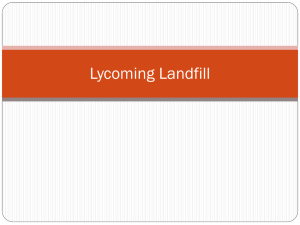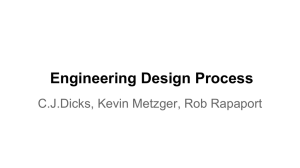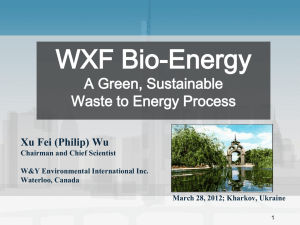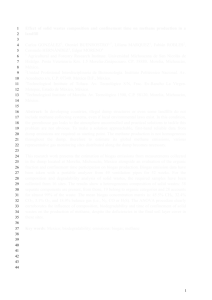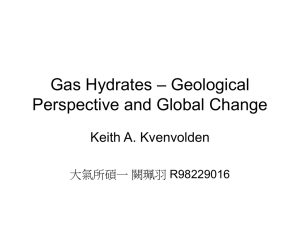Electrical Energy From Solid Waste
advertisement
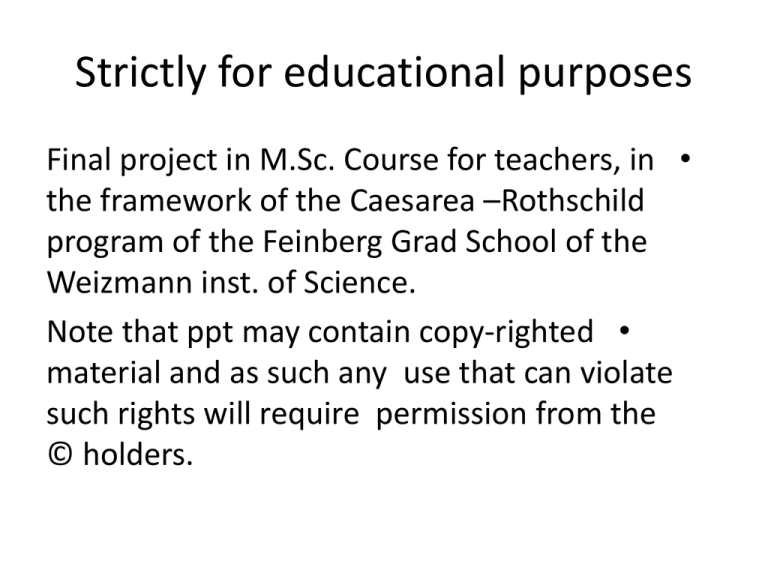
Strictly for educational purposes Final project in M.Sc. Course for teachers, in • the framework of the Caesarea –Rothschild program of the Feinberg Grad School of the Weizmann inst. of Science. Note that ppt may contain copy-righted • material and as such any use that can violate such rights will require permission from the © holders. Electrical energy from solid waste Solid waste Waste is an inevitable product of modern society. Population growth and rising standard of living with increased consumption rate, exact a heavy environmental price in natural resource depletion and waste accumulation. In Israel, the amount of waste has grown at a rate of about 5% annually. Each resident generates an average of about two kg/day of garbage, which adds up to a total amount of waste of more than five millions tons per year. Composition of solid waste in Israel 4.5% 4.0%4.5% 4.0% 3.0% 41.0% 15.0% 24.0% Organic waste Plastic Textile Miscellaneous Paper Metals Glass Dipers • 75% of the waste is dumped into landfills • 25% of total waste (household, commercial and industrial waste) is recycled. • 13% of household waste is recycled What is biogas? Biogas consists mainly of methane (CH4) and carbon dioxide (CO2), in addition to a small fraction of a variety of other gases. Biogas is known to have a negative environmental impact for its contribution to the "greenhouse effect“. To minimize the global warming effects, associated with climate change, we must reduce greenhouse gas emissions. Another important global challenge is to secure energy supply, as most of the conventional oil and gas reserves are located in politically unstable regions. Bio-Digestion process of organic waste In the first phase (1-5): Requires 2 molecules of ATP per molecule of glucose : In stages 6 to 10 four ATP molecules are formed and two molecules of NADH Properties of landfill gas Value Attribute 40-50 )oC(Temperature 1.02-1.06 Density Saturation Water content 100-140 Calorific Value (kcal) 0.11-0.16 )kilowatt-hour, kWh( Major development of landfill gas formation ( IV) and break-down Ratio of the gases that make up the biogas up till stage IV (Merz and Stone: 1970) Average (percent by volume) Methane CH4 CO2 5 88 Nitrogen N2 5.2 21 76 3.8 29 65 0.4 40 52 1.1 47 53 0.4 48 52 0.2 51 46 1.3 47 50 0.9 48 51 0.4 The time period from closing the landfill (month) 0-3 3-6 6-12 12-18 18-24 24-30 30-36 36-42 42-48 It is necessary to collect and treat the generated gas because of the following reasons: • Under certain conditions and concentrations, methane and hydrogen form an explosive and flammable mixture. • In low and closed spots, biogas results in suffocation hazard for people. • Biogas may leak out of the dump site and damage agricultural crops and surrounding vegetation • Biogas contains toxic gases which pose health hazards • Gases cause odor nuisances Sanitary landfill Waste disposal method. Considerably reduces environmental hazards and reduces public health risks and safety. The method typically utilizes ground outlets such as valleys, dry rivers, mines, and quarries. Sanitation landfill method requires: Clay-like layer Spread sealed plastic sheets on top of the clay-like layer to prevent the waste leachate to seep into the groundwater תשתיות נדרשות ממטמנת פסולת Covering the sheet with sand to filter the leachates and protecting the plastic from tearing damage Waste is spread in compacted layers with a maximum height of 60 cm Each layer of compacted waste is covered with 15 cm height of dirt, in order to reduce the hazards of odors and so as not to attract birds. Once the stack reaches 10 meters height, it should be covered with soil and later with plastic sheets, to prevent percolation of rain water that could cause leaching of contaminants into groundwater. Cover with soil at a height of 60 cm, at least. The site is divided into dump chambers of a size determined in accordance with the topography of the area and the amount of waste intended for it. Each chamber has different pipes: Leachate collection pipe - runoff drainage and treatment to prevent contamination of groundwater. Groundwater sampling pipeline , designed to test the penetration of pollutants into groundwater Biogas collection pipeline - to prevent explosions and fires, in addition to preventing leakage of biogas to the atmosphere. Moreover, the pipeline transfers the biogas to the generator. Leachates : the liquid found in organic substance waste. Its concentration increases during compaction. Leachates are rich in organic particles, and have high acidity due to the metals concentration. Leachates are considered to be hazardous to groundwater. in order to insure groundwater quality, leachate collection pipe installed to transfer it to a treatment facility (a process similar to wastewater treatment), in addition to monitor tubes Disadvantages of the landfill: Advantages of the landfill: Waste of resources - many raw Suitable for all types of waste. materials are recyclable. Inexpensive Waste of sand. No residues of waste requiring further treatment Waste of land. Emissions polluting the air. Simple to operate Flexibility to absorb quantities of waste. Does not cause severe environmental hazards. Minimal damage to groundwater. Time till degradation for various materials Tin can - 100 years Banana peel - a few weeks Disposable diapers - 500 years Newspaper - Month Plastic cup - 1000 year Cotton trousers - 5 months Glass bottle - 1 million years Styrofoam packaging - NEVER! Wool socks – a year Wooden rolling pin - 10 years Leather wallet - 50 years Effect of ambient temperature on methane production: : Feasibility study for the establishment of electricity generation facility from solid waste– for the city of Karmiel The purpose of the project is to generate electricity from Municipal Solid Waste Karmiel. Amount of waste in Karmiel is 50 tons per day, but the feasibility limit to establish a landfill is a minimum of 1,000 tons of waste per day. Additional feasibility problem, is the lack of place. This limits the landfill to30-40 dunam. Moreover, negative construction cost reimbursement, need a period of 4-7 years to refund the cost of construction Thanks to David Malka, Director of Environmental Quality Department , Karmiel Evron waste disposal site Operates since 1971 in former limestone quarry. Rate at which household waste is dumped ranges from 150,000-225,000 tons / year. Till 2013, ~ 6.5 million tons of waste dumped at the site. Landfill area estimated at ~ 30 hectare. ~ 80% is household waste Waste does not pass a screening process. Evron gas management system design : Gas management system - includes three basic components: • gas production unit (wells): Location and depth of the wells was determined according to waste composition, its thickness, moisture content, coverage character. 25 wells were drilled and constructed to a depth of between 14-30 meters from the ground in cell A. • Gas transmission facilities (pipes ,valves ,condensation trap): gas pipeline size was calculated to insure the gas flow for each cell and the whole landfill . • Vacuum system (gas compressors) and gas treatment facility (Torch): gas production system includes three centrifuge compressors and a torch. Each compressor has an output capacity of 500 to 2500 m³ / h in a maximal sub pressure of at least 200 mbar, with a torch that has a similar maximum flow rate. Kibbutz Evron landfill Costs and payback: Landfill construction cost 5 million NIS for landfill construction working space. excluding land cost and maintenance, taxes, and manpower. 3.5 million NIS for generator, with 60,000 hr life span (~ 7 yr non-stop). Transportation cost: 150 trucks per day INCOME Waste receipt rate: Average travel distance: Fuel consumption / km : Fuel price \ lit: 20.6 km 3 km / lit 8 NIS/lit Total Cost:74,160 NIS/day 158,000 NIS/day Waste compressing cost : Two tractors each day Work Duration 10 hours \ day Distance 400 km \ day Fuel consumption 50 liters \ day Fuel price \ lit: 8 NIS/lit Total Cost : 800 NIS The cost of purchasing and maintening 1000 kW generator 24 hr/day: 480 NIS/day NIS 0.2 *hours 24 *kW 1000 Total Investment: 75,440 NIS/ day 27,535,600 NIS/ year Payback: 82,560 NIS/ day Process energy cost : Power output (kWd) 31,200 methane volume m3 / d 107,500 Waste quantity (tonnes) T/day 1000 note : The amount of methane emitted from waste digestion, calculated according to northern Germany, is 100 kg of methane for one tonne of waste, . The impact of temperature on gas production was taken into consideration (average temperature summer and winter). The difference in the output of methane between day and night was not discussed. The amount of electricity produced accounts for ~80% of the electricity consumed in the Kibbutz, which is estimated ~1300 kWh. 20% of electricity supplied by national grid, which is estimated ~325 kWh. kWh price determined for the process is taken from the link: http://www.pua.gov.il/Sip_storage/FILES/5/3115.pdf Life span of the system up to overhaul : 60,000 - 80,000 hours Working time per year: 8760 hours Years of service: 30-40 years Work Payback time: (3.5-4 years) Sources: Biogas production: current state and perspectives 2009, Peter Weiland, Adani, F., Calcaterra, E., Malagutti, L., 2001. Preparation of a test for estimating biogas production from pretreated urban waste. Proceeding Sardinia 2001 Eight International Waste Management and Landfill Symposium. Cagliari, Italy. By the MOTHER EARTH NEWS editors. May/June 1970, Convert Waste to Energy with Methane Production H.G.Bingemer and P.J.Crutzen 1987, The production of methane from solid wastes Ann C .Wilkie, Ph.D. 2005, Anerobic digestion: Biology and benefits. .Bullard, R. D. (1971). Solid Waste Sites and the Black Houston Community .Sociological Inquiry, 53(2-3), 273-288 :קישורים http://www.bayadaim.org.il/2012/12/%D7%91%D7%99%D7%95%D7%92%D7%96-%D7%90%D7%A6%D7%9C%D7%9A%D7%91%D7%91%D7%99%D7%AA%D7%97%D7%9C%D7%A7-%D7%90/#anc6 http://www.sviva.gov.il/subjectsEnv/BusinessLicensingIndustry/Int Management/Documents/IntegratedGuidelinesIPPC092013.pd f http://www.motherearthnews.com/renewable-energy/waste-toenergy-methane-productionzmaz70mjzkin.aspx#axzz2pDxDvbqz http://www.small-farm-permaculture-and-sustainableliving.com/methane_generator.html http://environmentvictoria.org.au/content/organic-waste http://www.doityourself.com/stry/how-to-convert-organic-waste-intoelectricity#.UsVCKNIW2VM http://en.wikipedia.org/wiki/Waste-toenergyhttp://www.adamteva.org.il/_Uploads/dbsAttachedFiles/mis s.pdf http://en.wikipedia.org/wiki/Met



